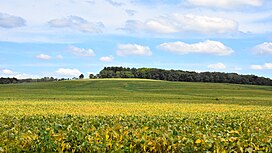Charles Mound[3] is a gentle, 1,235-foot (376 m) high hill located in Scales Mound Township, Jo Daviess County, Illinois, United States. It is 2 miles (3.2 km) northeast of the small town of Scales Mound, and 11 miles (18 km) northeast of Galena. Despite its name, Charles Mound is a naturally occurring, erosional feature and is not to be confused with the intentional mounds created by native cultures. It is the highest natural point in the state and is thus considered a state highpoint. It is the lowest state highpoint in the Midwestern region of the United States.
| Charles Mound | |
|---|---|
 Looking eastward at Charles Mound, the highest point in Illinois from Elizabeth Scales Mound Road, September 2016 | |
| Highest point | |
| Elevation | 1,235 ft (376 m) NAVD 88[1] |
| Prominence | 95 ft (29 m)[2] |
| Listing | U.S. state high points 45th |
| Coordinates | 42°30′14.55931″N 90°14′23.01334″W / 42.5040442528°N 90.2397259278°W[1] |
| Geography | |
| Country | United States |
| State | Illinois |
| County | Jo Daviess |
| Township | Scales Mound |
| Topo map | USGS Shullsburg |
| Climbing | |
| Easiest route | Unpaved road |
Geography
editCharles Mound is the highest natural point in Illinois. (The highest point is the Willis Tower, formerly known as the Sears Tower.) The top of the hill is about 0.25 miles (400 m) from the Wisconsin border. It is within the Driftless Area, a region of Illinois, Iowa, Minnesota, and Wisconsin that was not covered or ground down by the last continental glaciers. The hill itself is an erosional remnant, similar to that on which the original village site of Scales Mound was located. Shallow Elizabeth silt loam soil is on the summit and the surrounding area has deeper silty clay loam of the Lacrescent series.[4]
Geology
editAs mapped in the early 1960's by Mullens,[5] Charles Mound is an outlier and erosional remnant of Silurian Edgewood Dolomite overlying strata of the Ordovician Maquoketa Formation. The Maquoketa Formation consists of dark-gray clayey siltstone and silty dolomite that occurs in beds that are 2 in (5.1 cm) to 5 ft (1.5 m) thick. Within the Formation, layers of dark grayish-orange silty dolomite that are up to 2 in (5.1 cm) thick separate the beds of siltstone and silty dolomite. A prominent grayish-orange and grayish-yellow granular dolomite bed that ranges from 3 to 13 in (7.6 to 33.0 cm) in thickness, which contains abundant fossil bryozoa fragments, locally outcrops near Charles Mound. The Edgewood Dolomite is Unconformably overlying, and in erosional contact with, the Maquoketa Formation. The maximum thickness of Edgewood Dolomite preserved beneath Charles Mound is about 50 ft (15 m). The Edgewood Dolomite outcrops at the northwest and southeast ends of Charles Mound, and there presents as thin beds of grayish-orange and olive-gray medium-grained dolomite that contains light-gray chert nodules. The chert nodules are irregular in shape, 1 to 3 in (2.5 to 7.6 cm) thick and as much as 8 in (20 cm) long. Just southwest of Charles Mound is an abandoned prospecting shaft for lead-zinc ore.[5]
Settlement
editElijah Charles, one of the region's first permanent settlers, arrived in 1828 and settled at the base of the mound and the hill assumed his name.[6]
Access
editCharles Mound is located on rolling farmland. The land owners, Jean and Wayne Wuebbels, allow public access on the first full weekends of the months of June, July, August, and September.[7]
See also
editReferences
edit- ^ a b "Charles". NGS Data Sheet. National Geodetic Survey, National Oceanic and Atmospheric Administration, United States Department of Commerce. Retrieved 2008-12-17.
- ^ "Charles Mound, Illinois". Peakbagger.com. Retrieved 2012-10-17.
- ^ U.S. Geological Survey Geographic Names Information System: Charles Mound
- ^ "SoilWeb: An Online Soil Survey Browser | California Soil Resource Lab". Archived from the original on 2021-11-19. Retrieved 2020-03-28.
- ^ a b Mullens,T. E., 1964. Geology of the Cuba City, New Diggings and Shullsburg quadrangles, Wisconsin and Illinois. U.S. Geological Survey Bulletin, no. 1123-H, p. 437-532.
- ^ Mansberger, Floyd (1990-04-02). "Scales Mound Historic District" (PDF). National Register of Historic Places Registration Form. Illinois Historic Preservation Agency. Archived from the original (PDF) on 2008-06-25. Retrieved 2008-12-17.
- ^ "2011 Access Dates for Illinois". The Highpointers Foundation. 2011-02-01. Archived from the original on 2014-10-16. Retrieved 2011-08-20.
External links
edit- "Charles Mound". Property Information Report. Illinois Geographic Information System. Archived from the original on 2011-07-20. Retrieved 2008-12-17.
- "2003 Highpointers Convention". The Highpointers Foundation. Archived from the original on 2007-03-03. Retrieved 2008-12-17.
